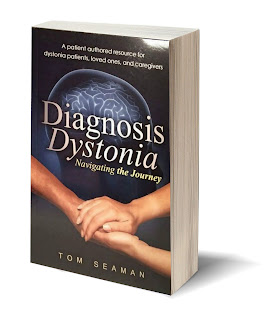I can appreciate these reactions because I experienced them all at one time or another. However, it was not when the doctor said, “You have cervical dystonia.” It was in the weeks, months, and years that followed that I rode the emotional roller coaster. I was actually pretty relieved at first because I had already self diagnosed so it was good to get a doctors’ confirmation so I could move in positive directions regarding treatments and lifestyle changes.
If the dystonia diagnosis isn’t enough, even more deflating to hear is, “there is no cure.” This can cause anger, fear, and depression, to name but a few reactions. However, it is important to put this into perspective. How many diseases/disorders that people live with today, and live very well with, have a cure? I don’t have the answer to this, but it is pretty low. Most diseases are managed, not cured, and dystonia is one of them.
Just like people with diabetes, multiple sclerosis, Parkinson’s disease, celiac disease, AIDS, etc., all of which have no cure, people with dystonia can live a fulfilling life with proper treatments and lifestyle changes. Please don’t allow yourself to believe that you won’t have a happy, functional life simply because dystonia has no cure. Many people have transformed their lives by finding successful ways to manage their symptoms.
Accepting the challenge
The dystonia diagnosis is not the definition of your life. It is not the book of your life. It is just one chapter of your life among many other chapters. While it can alter the course of your life from subtle to dramatic ways, it need not be how you define yourself. It is not what happens to us in life that defines us. It is what we do with it that defines us.
Work hard every day to think about your life right now and not the life you once had. This is the way everyone should live, dystonia or not. The past is over. Also, don’t predict where you might be in six months or a year. As with all of life, dystonia is unpredictable so it is best to roll with the punches versus anticipating “what might happen.” Being consumed with worry can prevent you from helping yourself right now. Take each day one at a time.
When I struggle in this area I say the following affirmation: “I relax into the flow of life and life flows through me with ease.” I read this in a book by Louise Hay called, You Can Heal Your Life (1984), which I highly recommend.
Saying how much we hate dystonia won’t make it go away. When we say we hate something, anger, bitterness, and resentment consume us. Instead, find a way to cohabitate with your dystonia because no amount of anger will take it away. Fighting any adverse condition will only increase its power over us.
We have a choice to feel how we want about everything. Mindfulness (non-judgmental acceptance of thoughts and feelings) tells us that there is peace in accepting things the way they are in this moment. This acceptance gives us the space to just be, and with that space, the opportunity to let go.
Focus on things just as they are; not the way you think they should be. The changes that can come out of this acceptance are incredible. As Michael J. Fox said, “Acceptance doesn't mean resignation. It means understanding that something is what it is and there's got to be a way through it."
If you have a racing mind full of questions and concerns, please reach out to the many online forums, support groups in your area, and dystonia organizations to talk to others who can relate. Dystonia can be distressing and exhausting. Share what you are thinking and feeling. Learn about treatment options and coping mechanisms. You need not feel any shame. You have done nothing wrong to be in this situation. Take control and do what is best for you in order to get better.
Tom Seaman is a Certified Professional Life Coach in the area of health and wellness, and author of the book, Diagnosis Dystonia: Navigating the Journey, a comprehensive resource for anyone suffering with any life challenge. He is also a motivational speaker, chronic pain and dystonia awareness advocate, health blogger, and volunteers for the Dystonia Medical Research Foundation (DMRF) as a support group leader, for WEGO Health as a patient expert panelist, and is a member and writer for Chronic Illness Bloggers Network. To learn more about Tom’s coaching practice and get a copy of his book, visit www.tomseamancoaching.com. Follow him on Twitter @Dystoniabook1 and Instagram



No comments:
Post a Comment